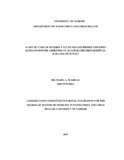| dc.contributor.author | Warille, Maria A | |
| dc.date.accessioned | 2017-01-05T07:32:01Z | |
| dc.date.available | 2017-01-05T07:32:01Z | |
| dc.date.issued | 2015 | |
| dc.identifier.uri | http://hdl.handle.net/11295/99048 | |
| dc.description.abstract | Introduction: Malnutrition is a critical public health concern in south Sudan where an estimated 200,000 children under five are at risk of being malnourished. With the ongoing conflict, the number is expected to rise due to displacement and food insecurity. Studies have shown that adequate and timely treatment of these children will lead to reduced mortality.
Objectives: The primary objective of the study was to determine the proportion of children appropriately managed for severe acute malnutrition (SAM) according to WHO guidelines at Al-Sabah Children Hospital, and to determine the availability of the inventory commodities necessary in the management of SAM.
Study Design: A hospital based longitudinal survey was conducted.
Study area: Al-Sabah Children Hospital (ACH) Outpatient department and Malnutrition wards.
Study Population and duration: Children admitted with diagnosis of severe acute malnutrition aged 6-59 months from 4th February to 4Th April 2015.
Data collection procedure: The principal investigator visited the outpatient Department and malnutrition ward daily to recruit patients. The nutritional status of the child was assessed, this included measuring the height, weight and mid upper arm circumference. A data pro forma sheet was prepared according to steps in the WHO guidelines and applied to each patient thus assessing care provided during hospitalization. Information collected was supplemented with information obtained through a structured interview with the care givers and direct, daily observations on the wards.
An inventory of commodities necessary in the management of severe malnutrition, availability and reliability of supplies was done using a self-administered questionnaire with the nurses and nutritionist.
xiv
Results:
Overall, 49% of children had Marasmus and tended to be older than those who had kwashiorkor. Common co-morbidities at admission were malaria (42%) and gastroenteritis (39%). Of the eight steps of care evaluated, five steps were correctly followed in more than 70 % of cases. The proportion of children appropriately managed were 77% in step 1, 59% in step 2, 85.4% in step 3, 98% in step 4, 58 % in step 5 and 6. 97% in step 7 and 86% in step 8. There was lack of some essential commodities necessary for the management of severely malnourished children at ACH.
Conclusion:
Quality of care for children admitted with severe malnutrition at Al-Sabah children's hospital was with more than 50% of children appropriately managed in all eight steps. | en_US |
| dc.language.iso | en | en_US |
| dc.publisher | University of Nairobi | en_US |
| dc.rights | Attribution-NonCommercial-NoDerivs 3.0 United States | * |
| dc.rights.uri | http://creativecommons.org/licenses/by-nc-nd/3.0/us/ | * |
| dc.subject | Audit Of Care Of Severely Acute Malnourished Children Aged 6-59 Months Admitted At Alsabah Children Hospital- Juba (South Sudan). | en_US |
| dc.title | Audit of care of severely acute malnourished children aged 6-59 months admitted at Alsabah Children Hospital- Juba (South Sudan). | en_US |
| dc.type | Thesis | en_US |
| dc.description.department | a
Department of Psychiatry, University of Nairobi, ; bDepartment of Mental Health, School of Medicine,
Moi University, Eldoret, Kenya | |


